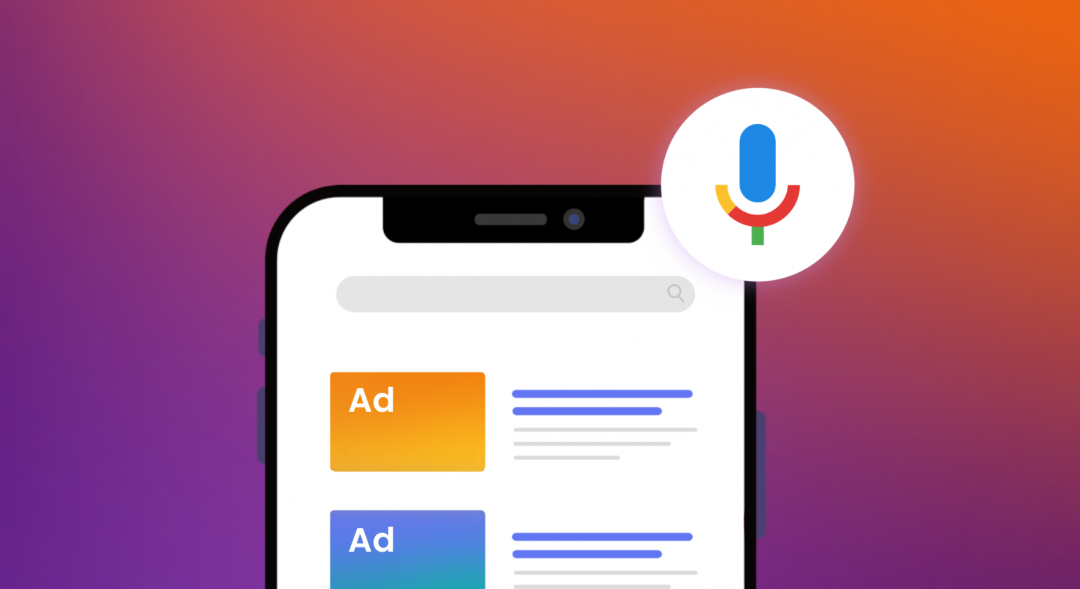No longer the gimmick it once was when Siri launched in 2011 - voice search marketing is now a major component of the marketing landscape.
Voice assistants are everywhere - on your customers’ smartphones, in their cars, and in virtually every room in the house - thanks to the growing popularity of smart speakers.
They’re more capable than ever, too. Voice assistants now have an accuracy rate of over 95%, and can help users discover and buy products quicker than ever.
In short, your customers can use voice assistants to:
- Discover your product/brand
- Learn more about your product/brand
- Buy your products
They can even use them to defend their homes from intruders…

Death by Roombas aside, the gap between marketers who consider voice search marketing in their campaigns and those who don't is continuing to grow as voice assistants become increasingly popular (and capable).
By not optimizing for voice search, marketers actively miss out on brand awareness, product visibility, and conversions.
In the 5 minutes it takes to read this blog, you’ll learn everything you need to know about voice search marketing, including:
- Why voice search marketing is important (+ new some eye-opening new stats)
- How to understand & interpret voice search behavior
- Optimizing PPC campaigns for voice search
- The analytics you'll need to measure to refine voice search marketing

TL;DR - key takeaways for voice search optimization:
Short on time? Here are the key takeaways to help you optimize your paid search campaigns for voice:
- Focus on natural language, long-tail keywords, and local keywords.
- Use varied, conversational ad copy to address user queries at every stage of the buying cycle.
- Leverage voice search data to understand user intent for better targeting.
- Ensure ads and landing pages are mobile-friendly, fast-loading, and informative.
Voice search marketing: Key stats and why you should care
Voice search marketing is here to stay. Don't believe us? Take a look at the stats:
- Stats from PwC show that 65% of 25-49-year-olds speak to their voice assistants at least once a day - and this number is only increasing as smart speaker adoption rates increase.
- Every month, over 1 billion voice searches are made by users.
- As of 2023, more than 27% of searches in the Google App are done by voice.
- By 2020, nearly half of all US households had a smart speaker. That figure is expected to rise to 75% by 2025. (And let’s not forget that almost everyone has one on their smartphone!)
And we’ve saved the juiciest stat until last: According to Statista, global purchases made using voice assistants increased from $4.6bn in 2021, to nearly $20bn in 2023. Put another way, that’s almost 400% growth in just two years.
Why voice search matters for PPC marketers
A quick glance at the stats above reveals a huge, largely untapped market out there for voice search optimization in PPC campaigns.
PPC marketers are often neglecting potential competitive advantages by failing to incorporate voice search best practices into their search campaigns. Here’s what they’re missing:
- Increased conversions: More users than ever are purchasing via voice search. Your search ads could be top results for user queries and voice-initiated purchases when optimized for voice.
- Local dominance: Voice search is heavily localized, offering opportunities for businesses to capture local market share.
- Standing out from the crowd: Many paid media marketers don’t consider voice search when planning their campaigns. By optimizing for voice search early, you’re in a great position to gain an edge over the competition.
- Enhanced user experience: By understanding and catering to voice search queries, you can improve the overall user experience and drive home additional conversions.
Key voice search characteristics
So what makes voice search marketing different from regular search marketing?
In short, voice search is characterized by:
- Conversational language: Voice search users tend to use natural language queries, often asking questions rather than simply saying keywords.
- Local intent: Many voice searches are location-based, as users seek nearby businesses or services.
- Long-tail queries: Voice searches often involve longer, more specific queries.
- Information-seeking: Users often seek specific information, like hours of operation, addresses, or product details.
- Transactional intent: Users may be ready to make a purchase, especially for products or services with high purchase intent.
- Immediate results: Users expect quick, direct answers.
These characteristics necessitate a different approach to optimization when compared to traditional text-based search.
Hey, Siri - how do I optimize PPC campaigns for voice search?
Looking for an actionable list to optimize your paid campaigns for voice search? Follow the steps below to gain a competitive edge and win new customers:
1. (Long-tail) keywords are king:
One of the first lessons you’re likely to learn in the PPC world is this: target short keywords for reach, target long-tail keywords for valuable leads.
Here’s the good news - when it comes to voice search, long-tail keywords can provide leads and reach. If you want your PPC ad to appear in voice search results, ditch the short-tail keywords.
- Focus on long-tail keywords: Identify conversational phrases and questions that users might ask.
- Leverage question-based keywords: Incorporate question words like "where," "when," "how," and "what" into your keyword list.
- Consider local search terms: If your brand has physical stores or locations, optimize for location-based keywords to target nearby customers.
2. Ad copy optimization:
With the growing popularity of voice search, more consumers are speaking rather than typing. This should be reflected in your copy:
- Use natural language: Write ad copy that mimics conversational language.
- Highlight local information: Include your business location and contact information to help customers easily find what they’re looking for.
- Create compelling calls to action: Encourage users to take the desired action, such as calling or visiting your website.
3. Understand the buying cycle:
In order to make the most of your voice search marketing efforts, understanding where your audience is in the buying cycle is key.
There are four stages of the buying cycle:
- Awareness: Awareness of a problem or a need for a product
- Consideration: Researching product options that can fulfill the need
- Evaluation: Evaluating viable products to figure out the best option
- Purchase: Pulling the trigger and buying your product
Generally speaking, people who ask ‘what’ or ‘who’ questions are at the start of the buying cycle. They’re looking for more information, and you can leverage this to put your brand at the forefront of their research.
Those asking ‘when’ and ‘where’ questions are typically much closer to conversion. Help them out by making key information easy to find.
PPC marketers will want to bid on those ‘when’ and ‘where’ phrases, as they’re more likely to convert.
You can still bid on other question-based keywords to support users throughout the entire journey, however when it comes to voice search ROI, you’ll want to spend big on the questions that lead to conversions.
4. Landing page optimization:
People who use voice search are far more likely to land on the mobile version of your site. Optimize accordingly:
- Fast loading speed: Voice search users expect quick results, so ensure your landing pages load swiftly.
- Mobile-friendliness: Optimize your landing pages for mobile devices, as many voice searches occur on smartphones.
- Clear and concise content: Provide relevant information in a clear and easy-to-understand format.
5. Local SEO:
Voice search is often used to find local businesses. If you have a physical store or location, you’ll want to leverage this first and foremost:
- Claim and optimize your Google My Business listing: Ensure your business information is accurate and up-to-date, and your listing contains all the information customers could possibly need.
- Local keywords: Try using long-tail location keywords to draw in nearby users. For example, “Bike shops near Brooklyn, New York” or “Italian Restaurants in Hammersmith, London”.
- Build local citations: Increase your business's online visibility by creating citations on directories and review sites.
- Encourage reviews: Positive reviews can boost your local organic search rankings, and positively influence paid voice search results.
6. Leverage voice search platforms:
- Explore voice search advertising options: Some platforms offer specific ad formats for voice search.
- Monitor voice search analytics: Track voice search performance to identify opportunities for improvement.
Want to see voice search marketing optimization in action? Here are a couple of examples:
- Unoptimized: "John’s Car Dealership | New & Used Cars"
- Voice-Search Optimized: "Need a new car? Visit John’s Car Dealership for New & Used Cars in London"
or
- Unoptimized: "Great Pizza | Fast Delivery"
- Voice-Search Optimized: "Looking for the best pizza near you? Try Jerry’s Pizza for great pizzas delivered to your door."
Additional voice search tips:
- Understand your target audience: Tailor your voice search strategy to the specific needs and preferences of your target market.
- Optimize, optimize, optimize: Continuously experiment with different keywords, ad copy, and landing pages to optimize your campaigns.
- Stay updated on voice search trends: Keep up with the latest developments in voice search technology and user behavior.
Using voice search analytics to improve results
Understanding how your voice search campaigns are performing is crucial for voice search marketing ROAS.
- Most PPC platforms offer insights into voice search queries, impressions, clicks, and conversions. Analyze this data to identify high-performing keywords and ad variations, as well as areas for improvement.
- Use Google Analytics to provide valuable information about user behavior and demographics.
- Look for trends in voice search queries to stay ahead of the curve and refine your strategy accordingly.
- Voice search is a dynamic landscape, so continuous monitoring and adjustment are key to maximizing voice search ROI.
Further ad spend optimization
Voice search has exploded in popularity in recent years, and there’s no sign of that boom slowing down anytime soon.
Marketers of all forms can no longer ignore the prevalence of voice search marketing. By getting into the habit of making your ad campaigns voice search compatible now, you’ll see exponentially better results in the years to come.
One constant with all forms of search marketing is the continuing prevalence of invalid traffic (IVT) and click fraud. As scrapers, competitors, proxy servers, click farms and more continue to run rampant - it’s more important than ever to understand how IVT impacts your marketing budget.
Using invalid traffic prevention software is the best way to monitor and prevent click fraud. Get a no-obligation 14-day free trial with Lunio, and learn how much of your ad budget is being wasted.



